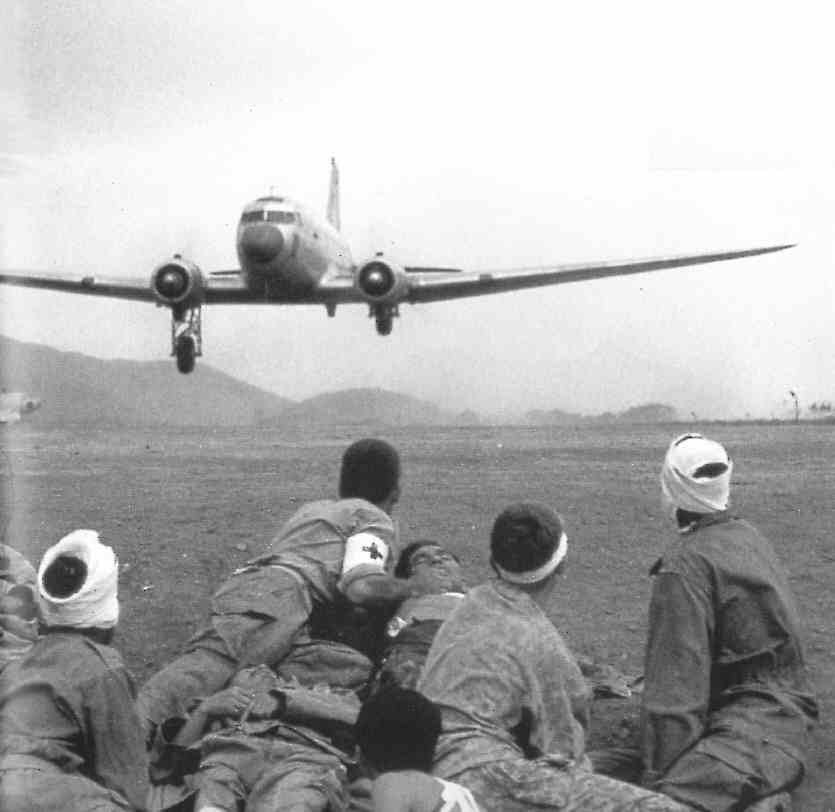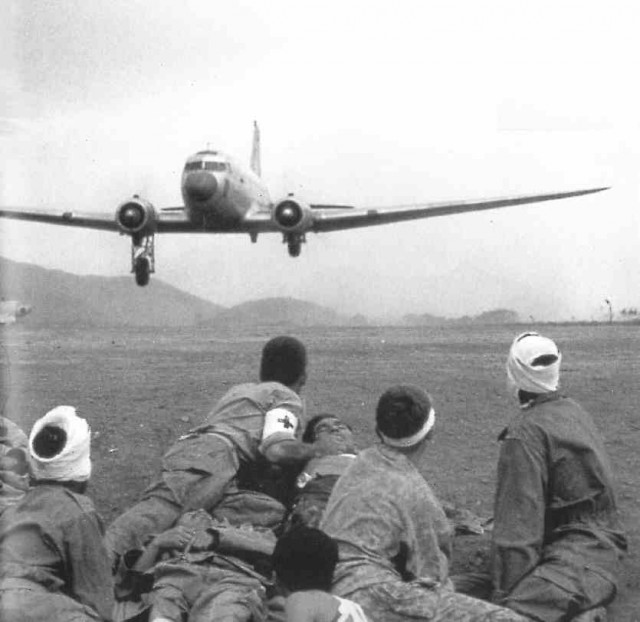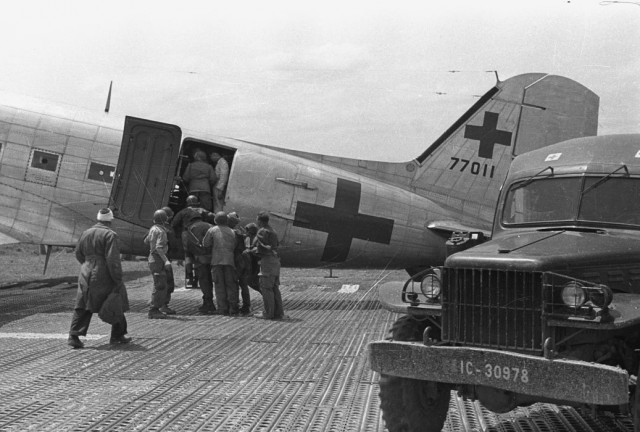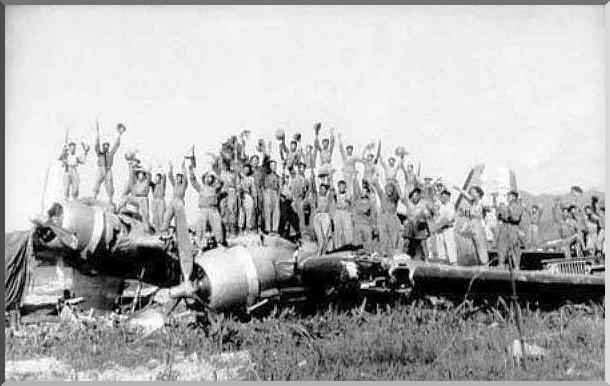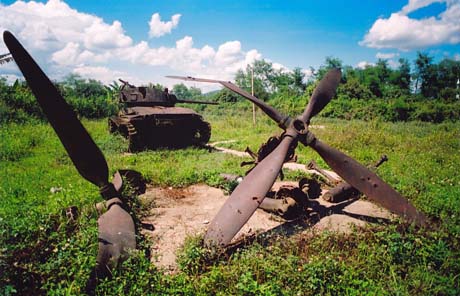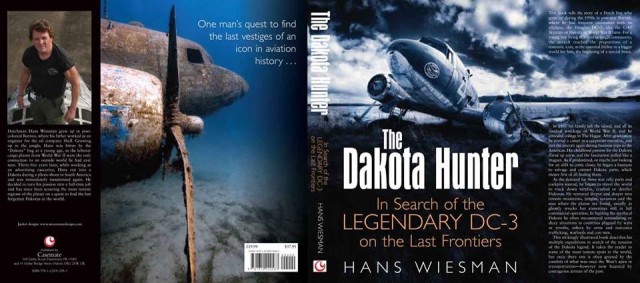French defeat in Dien Bien Phu, May 1954 heralded the US Military engagement in Vietnam.
With dramatic photos of the C-47’s / Dakota’s last flight out of Hell, Dien Bien Phu, Vietnam 1954.
With the siege war of the French troops in a desolate Army Camp in NW Vietnam coming to a close in April 1954, almost 70 Douglas C-47s made overtime to supply the camp. They flew in food, ammo and medical supplies, and on the way back to the South, they took hundreds of wounded soldiers from this Jungle Hell in the remote mountains near the Laotian border. It was an airstrip built by the Japanese during WWII and was selected by the French Army as a stronghold against the advancing nationalist Viet Minh forces under their legendary team of North Vietnam’s leader Ho Chi Minh and the master guerrilla warrior General Giap.
It will remain forever a disputable decision as to why the French opted to occupy such remote venue in the heart of enemy ruled territory that could only by supplied by air with long flights.and had no real strategic value in that outback. The battle that was about to develop there must have taken the French by total surprise, mainly due to what the enemy could deploy in fire power. With 50.000 troops, they dug in on the surrounding hills that overlooked the lower situated French camp. A bad starter but worse, the Viet Minh had done the impossible by transporting over 300 km of impenetrable jungle their disassembled heavy artillery, howitzers and guns for their final assault on the well defended camp.
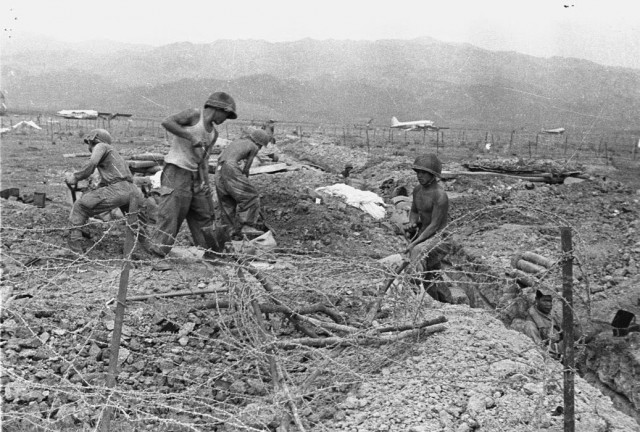
French Artillery with 105mm howitzers and 155mm guns was not able to neutralize the hidden enemy gun positions and soon, the daily supply flights of the Dakotas were made impossible as the Vietnamese activated their Russian made AA 37mm guns. Under heavy attack from that AA fire, a Dakota made the “Last flight out of Hell”. All who stayed behind in the camp must have realized the imminent “Doom’s Day”.
In one of the dramatic US Magazine pictures, we see the French soldiers digging trenches around the airstrip, in the hope to better defend the aircraft parked out there, but it all came to no avail. From the mountains seen in the backdrop of that photo, every day more Viet Minh guns were arriving and shelling the narrow airstrip at choice. The French artillery Colonel could not stop this carnage and committed suicide before the final onslaught started.
Inevitably, the moment came that the supply to the camp could only be done with paratrooper/ ammo droppings by a fleet of 50+ Douglas C-47’s and 12 C-119’s Fairchild Flying Boxcars. But every day, the Drop Zone became smaller and the pressure higher on the originally 30.000 French troops consisting of Army, Legionnaires, Paratroopers and Colonial Forces from North Africa as well as French Vietnamese soldiers and local T’ai Tribal forces. The supplies had to be dropped from higher altitude in a smaller area, so many of the drops incl. the ammo came in enemy hands and were used against the French force.
Finally, on the 7th of May 1954, the camp was overrun by the Viet Minh troops. To the dismay of the old Western Colonial Powers, almost 12.000 French troops were captured after the surrender: they were forced to make the ‘Walk of Shame’ over 300 km and many of them never returned from that agony. The first Indo-China War had come to its finale and brought an end to 100 years of French Colonial Rule in SE Asia in 1956. As the world might have thought that peace had finally settled in this region, the second Indo-China War was only just about to begin. That war would officially bring in the US Military engagement in Southern Vietnam from 1961 to 1975.
In the early 1950’s, the French Air Force in Vietnam was equipped with ‘vintage’ WW II American aircraft as the Grumman F8F Bearcat (see photo), the A-26 Attack Bomber, Sikorsky S-55 Helicopters and light spotter planes. Their inventory of all sorts of aircraft was rapidly filled from the the surplus stocks left over after the Korean conflict that had ended in 1953. Up to a total of 70 C-47’s and a large number of C-119 Flying Boxcars for para droppings of troops and heavy battle equipment were flown in via Japan.
Detail piquante: the deliveries were made and piloted by the controversial Civil Air Transport ( CAF), founded by the legendary USAF General Claire Chennault, who was since the war involved in SE Asian operations. First with the legendary “Flying Tigers”, the American Volunteer Group (AVG) that fought the Japanese Occupation Forces in 1941 with their “shark mouth” decorated Curtiss P-40 Warhawks. After the war, Claire Chennault became involved in the Chinese civil war and helped Gen. Chiang Kai-check to escape to Formosa (later named Taiwan). It was here that Chennault set up the CAF, allegedly a CIA supported airline for coveted activities that had no official US Government support. CAF later transformed into Air America, that played a role in the second Indo-China War, starting in the early 1960’s and spreading over Vietnam, Thailand, Laos and Cambodia.
On one photo, we see the Victory dance of the Viet Minh troops on a burnt C-47 left on the shelled airstrip, as a symbolic dismissal of the Colonial Power. The day of Victory for the Viet Minh was a day of Infamy for the French Army and Government. In the final stage of the siege of Dien Bien Phu, the French Army had desperately begged for help from the USAF with deployment of massive air raids against the Communist forces in the mountains. With carpet bombing raids from the B-29 Super Fortress fleet that could fly in from the Island of Okinawa, the threatening Viet Minh troops and gun positions could be annihilated in a matter of days.
This request is considered by some as the first seed of later American involvement in the second Indo-China War (1960-1975). But President Eisenhower along with many of the US Military strongly opposed against any support to the French request, as it could be considered by the free world and the ex-colonial nations as an attempt to keep up a Colonial Power that was in its final and fruitless struggle for survival in SE Asia. While USA had strongly promoted the liberation of former Colonies (Indonesia, India), it ran here in a split, that had far reaching consequences. There were many in the US of the mid 1950’s who advocated to interfere, likely fed more by the fear for an advancing World Domination of Communism than helping the French in their dreadful situation.
Ironically, the smoldering conflict between North and South Vietnam appeared to take a similar path of development as with North and South Korea, leading to a confrontation with China between 1950-1953. Spurred by the victory in South Korea, US President J.F. Kennedy, after long hesitation and with only stealthy supplies to the South Vietnamese regime, stepped in with open military support in May 1961 by sending 400 US Army Special Forces to train the South Vietnamese Army.
History took the escalating war in another direction than anticipated but this blog is not a political forum to make a judgement over what happened in the ensuing years, This is only a small contribution to look back at what happened there 60 years ago in a remote jungle camp in North Vietnam: a forgotten battle that involved armies from 6 different countries. Time to forgive (Vietnam and USA have much better relations now than Vietnam has with China) but not to forget. One day I hope to go there, visit the camp and see the remnants of that lost battle. Maybe I can come closer with that to the feelings of desperateness of the many soldiers who fought that forgotten war and must have felt totally abandoned by a colonial power that had no more good reason to be there. WWII had drastically reset the World Order, it took some nations another 10 to 20 years to see the New Light.
In my book “The Dakota Hunter” I describe my youth years in the Borneo jungle, from 1950-1957. Indonesia had just escaped from 3,5 years of Japanese occupation and 400 years of Dutch Colonial Rule. Its declaration of Independence in 1945 by Sukarno led to a long and violent up rise against the Dutch Army. Finally in 1950, the Independent Republic of Indonesia was recognized by the World, My father, working for Shell as an oil exploring engineer, moved in with our family. From Trinidad, we came to an unstable country that was ruined by the Pacific War which had evoked strong anti-Colonial/ Dutch sentiments. For a curious young kid like me, the material scars and remnants of that war were omnipresent. it was like a huge play station for me with bunkers, a stranded sub and wrecks all over, but the dangers and emotional tensions were always lurking. In those years, we continuously kept an open eye for an ´escape route´, just in case things might go berserk one day. I vividly remember my father coming home and informing us about the French defeat in Vietnam and his anxiousness that the “Commie Pest” would one day hop over to Indonesia.and wipe us all out. With no newspaper, radio or armed protection in our jungle outback station, we may have gone a bit paranoia from that harrowing “Dien Bien Phu” story. The only transport that could ever get us out from there was the venerable Douglas DC-3/ Dakota, the same aircraft which also brought the last French wounded soldiers out. One moth later, an US magazine arrived in our house with the photos of that C-47 in Vietnam as you see in this post, I must have felt a parallel: the pics are still printed in my memory since 60 years!. This plane was considered to be our life line and for me that aspect of the “last change savior” would even go further: it turned into a romantic symbol of “Fly-away to another World” that later in my life would attract me like a magnet to go travel the world and find the DC-3, as if that plane could bring back my intense childhood during those fascinating Borneo years.
I describe that passion for the Dakota and the global hunt I made since 1990 with 20+ expeditions to meet her again. 250 photos and 320 pages packed with adventure and history of an aircraft that changed the world. The Dakota had (and still has) a huge impact on my eventful life.
The book is published by Casemate USA/ UK, for sale by next week (after Easter 2015) and can now be ordered directly at Amazon USA/ UK, Barnes & Nobles, WHSmith, also via my website and is soon for sale in all major book stores in USA, Canada, UK, Aus, NZ, SA etc.
For more info about the book content/ ordering, merchandise, war- and DC-3/ C-47 related tales and photos, see also my new website www.dc3dakotahunter.com
You can follow/like my Facebook page on www.facebook.com/thedakotahunter.
Read the review of my book in your favorite War History Online magazine written by Mark Barnes
https://www.warhistoryonline.com/reviews/review-dakota-hunter-mark-barnes.html
